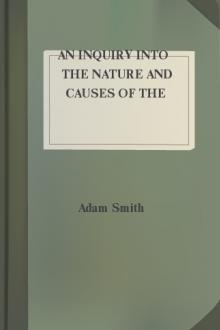The Wealth of Nations by Adam Smith (the best motivational books .TXT) 📕

- Author: Adam Smith
Book online «The Wealth of Nations by Adam Smith (the best motivational books .TXT) 📕». Author Adam Smith
The first public stamps of this kind that were affixed to the current metals, seem in many cases to have been intended to ascertain, what it was both most difficult and most important to ascertain, the goodness or fineness of the metal, and to have resembled the sterling mark which is at present affixed to plate and bars of silver, or the Spanish mark which is sometimes affixed to ingots of gold, and which being struck only upon one side of the piece, and not covering the whole surface, ascertains the fineness, but not the weight of the metal. Abraham weighs to Ephorn the four hundred shekels of silver which he had agreed to pay for the field of Machpelah.167 They are said however to be the current money of the merchant, and yet are received by weight and not by tale, in the same manner as ingots of gold and bars of silver are at present. The revenues of the ancient Saxon kings of England are said to have been paid, not in money but in kind, that is, in victuals and provisions of all sorts. William the Conqueror introduced the custom of paying them in money.168 This money, however, was, for a long time, received at the exchequer, by weight and not by tale.169
The inconveniency and difficulty of weighing those metals with exactness gave occasion to the institution of coins, of which the stamp, covering entirely both sides of the piece and sometimes the edges too, was supposed to ascertain not only the fineness, but the weight of the metal. Such coins, therefore, were received by tale as at present, without the trouble of weighing.
The denominations of those coins seem originally to have expressed the weight or quantity of metal contained in them. In the time of Servius Tullius, who first coined money at Rome,170 the Roman As or Pondo contained a Roman pound of good copper. It was divided in the same manner as our Troyes pound, into twelve ounces, each of which contained a real ounce of good copper. The English pound sterling in the time of Edward I, contained a pound, Tower weight, of silver of a known fineness. The Tower pound seems to have been something more than the Roman pound, and something less than the Troyes pound. This last was not introduced into the mint of England till the 18th of Henry VIII The French livre contained in the time of Charlemagne a pound, Troyes weight, of silver of a known fineness. The fair of Troyes in Champaign was at that time frequented by all the nations of Europe, and the weights and measures of so famous a market were generally known and esteemed. The Scots money pound contained, from the time of Alexander the First to that of Robert Bruce, a pound of silver of the same weight and fineness with the English pound sterling. English, French, and Scots pennies too, contained all of them originally a real pennyweight of silver, the twentieth part of an ounce, and the two-hundred-and-fortieth part of a pound. The shilling too seems originally to have been the denomination of a weight. When wheat is at twelve shillings the quarter, says an ancient statute of Henry III then wastel bread of a farthing shall weigh eleven shillings and four pence.171 The proportion, however, between the shilling and either the penny on the one hand, or the pound on the other, seems not to have been so constant and uniform as that between the penny and the pound. During the first race of the kings of France, the French sou or shilling appears upon different occasions to have contained five, twelve, twenty, and forty pennies.172 Among the ancient Saxons a shilling appears at one time to have contained only five pennies,173 and it is not improbable that it may have been as variable among them as among their neighbours, the ancient Franks. From the time of Charlemagne among the French,174 and from that of William the Conqueror among the English,175 the proportion between the pound, the shilling, and the penny, seems to have been uniformly the same as at present, though the value of each has been very different. For in every country of the world, I believe, the avarice and injustice of princes and sovereign states, abusing the confidence of their subjects, have by degrees diminished the real quantity of metal, which had been originally contained in their coins. The Roman As, in the latter ages of the Republic, was reduced to the twenty-fourth part of its original value, and, instead of weighing a pound, came to weigh only half an ounce.176 The English pound and penny contain at present about a third only; the Scots pound and penny about a thirty-sixth; and the French pound and penny about a sixty-sixth part of their original value.177 By means of those operations the princes and sovereign states which performed them were enabled, in appearance, to pay their debts and to fulfil their engagements with a smaller quantity of silver than would otherwise have been requisite. It was indeed in appearance only; for their creditors were really defrauded of a part of what was due to them. All other debtors in the state were allowed the same privilege, and might pay with the same nominal sum of the new and debased coin whatever they had borrowed in the old. Such operations, therefore, have always proved favourable to the debtor, and ruinous to the creditor, and have sometimes produced a greater and more universal revolution in the fortunes of private persons,





Comments (0)